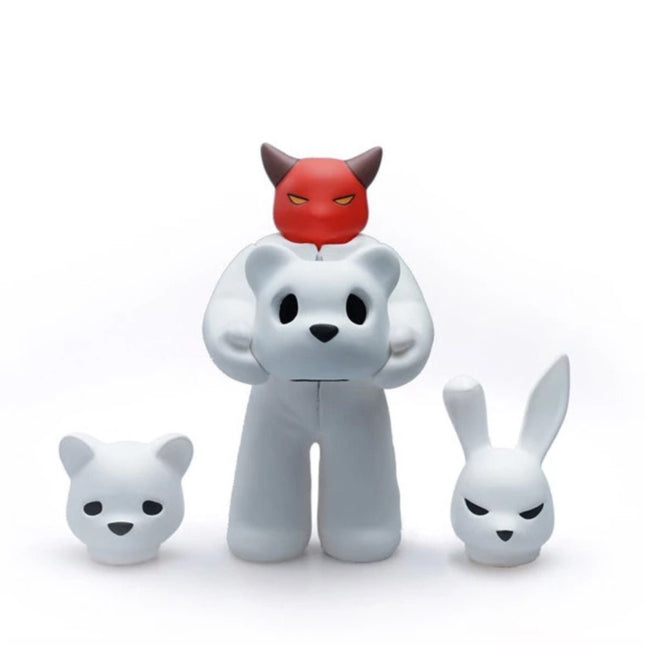
Religion
-

Luke Chueh Headspace Set 1 Vinyl Art Toy by Luke Chueh
Headspace- Set 1 Limited Edition Vinyl Art Toy Collectible Artwork by street graffiti artist Luke Chueh. 2016 Limited Edition Headspace Vinyl Fine Art Toy Displayed with Box Original Devil Creature in White Costume with Various Face Mask Helmets of Bears & a Rabbit. The Fusion of Street Pop Art and Graffiti Artwork in Luke Chueh's Headspace Set 1 In the dynamic sphere of contemporary art, the blending of street pop art and graffiti artwork has given rise to captivating and provocative collectibles. The Headspace Set 1 emerges as a quintessential embodiment of this hybrid genre. This limited edition vinyl art toy collectible, crafted by the renowned street graffiti artist Luke Chueh, represents a tangible intersection between accessible art and the artist's personal narrative. Released in 2016, this collection is not merely a toy but a statement, a slice of the artist's psyche rendered in three-dimensional form. The Headspace Set 1 is a testament to Chueh's distinctive aesthetic, a style that has cemented his place in the annals of street art history. The set is composed of one body and three interchangeable heads, allowing for a degree of customization that echoes the ever-evolving canvas of the urban landscape. The pristine white costume of the central figure is a canvas in itself, reminiscent of the blank walls upon which street artists impart their visions. The additional heads – bears and a rabbit, along with the original devil creature – serve as masks, revealing the multifaceted nature of identity and perception in the modern world. Luke Chueh's work is characterized by its dynamic power, often juxtaposing innocence with the macabre. The Headspace series is particularly illustrative, as it draws inspiration from the various influences shaping Chueh's life and career. Each interchangeable head represents a different aspect of the artist's experiences and inspirations. The bear, an oft-recurring motif in Chueh's work, might symbolize the struggle and resilience in his journey. In contrast, the rabbit head could signify cunning and adaptability, while the devilish facade perhaps reflects the artist's darker musings. The Impact of Headspace on Collectible Art and Pop Culture The release of Headspace Set 1 was more than a mere commercial venture; it was a cultural event resonating with collectors and street pop art enthusiasts. The limited-edition nature of this set adds a layer of exclusivity and desire, mirroring the ephemeral quality of street art itself – here today, gone tomorrow. Collectors of such pieces are not just acquiring a physical object but securing a piece of the narrative, a chapter of the artist's story. Furthermore, the Headspace series has played a pivotal role in elevating the status of vinyl art toys in the collectibles market. These items have transitioned from mere playthings to sought-after art pieces, occupying a unique niche where artistry and production intersect. Chueh's Headspace Set 1 exemplifies how street art's rebellious spirit and pop art's mass appeal can be distilled into a single, tangible form. The vinyl toy becomes a medium through which the street pop art narrative can continue to expand beyond the confines of gallery walls. Headspace and the Evolution of Street Graffiti Artwork The Headspace Set 1 is also a commentary on the evolution of graffiti artwork. Once considered a fringe activity, the art world has embraced graffiti, and artists like Chueh have been instrumental in this transition. By incorporating the ethos of graffiti into his vinyl creations, Chueh challenges the traditional boundaries of fine art. He brings the raw, unfiltered voice of the street into a format that is both accessible and gallery-worthy. This set's acclaim and desirability underscore the shifting perceptions of street art and its practitioners. No longer vilified as vandals, artists like Luke Chueh are recognized as legitimate and influential contributors to the contemporary art dialogue. With its vinyl art toys, the Headspace series becomes a medium that democratizes art, offering an entry point for those who might not have access to or interest in the more esoteric realms of fine art. In conclusion, the Headspace Set 1 by Luke Chueh stands as a landmark in street pop art and graffiti artwork. It encapsulates the essence of personal and cultural expression at the heart of Chueh's artistic vision. The set is not just a collectible but a multifaceted narrative, a piece of art history, and a bridge between the street and the gallery. Its influence extends far beyond the confines of its components, shaping the conversation around what art is and can be in the context of popular culture.
$318.00


